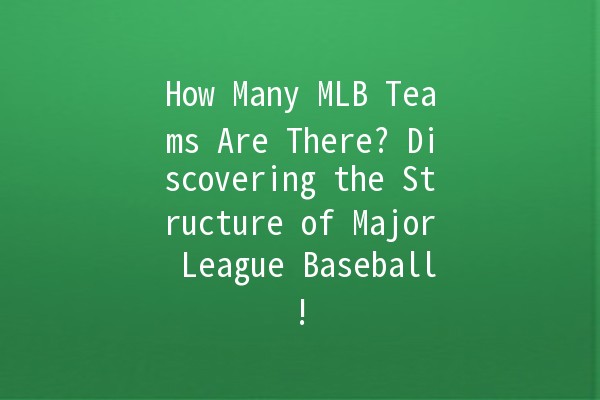Major League Baseball (MLB) is one of the oldest professional sports leagues in North America and a significant part of American culture. For baseball fans and curious minds alike, one of the foremost questions that arise is: How many MLB teams are there?
The Current Landscape of Major League Baseball
As of now, MLB comprises 30 teams
Understanding the League Composition
American League (AL): The AL currently has 15 teams. It is known for its designated hitter rule, which allows a player to bat in place of the pitcher.
National League (NL): The NL also consists of 15 teams but traditionally follows a different gameplay style, requiring pitchers to bat for themselves.
The Divisional Breakdown
Each league is further divided into three divisions, each containing five teams. Here’s how that looks:

American League East
American League Central
American League West
National League East
National League Central
National League West
This division not only increases regional rivalries but also plays a crucial role in the scheduling and playoff formats.
The Teams
American League Teams
AL East:
AL Central :
AL West:
National League Teams
NL East :
NL Central:
NL West:
Factors Influencing the Number of Teams in MLB
Expansion and Evolution of Teams
The number of MLB teams has gradually changed since its inception. The first season in 1876 featured only 8 teams. Over the decades, the league expanded, with notable expansions occurring in 1961 (expanding the AL), 1962 (NL), and the introduction of teams in cities that previously lacked a major league presence.
Maintaining Competitive Balance
Each team plays a set number of games throughout the season, culminating in the playoffs. The number of teams affects playoff formats and how many teams compete for the title annually. With the current 30team structure, playoffs are structured to include the top teams from both leagues, ensuring an exciting postseason.
The Role of Expansion Teams
The possibility of adding more teams has been a topic of discussion among fans and analysts. Cities such as Portland, Las Vegas, and Montreal have been proposed as potential new homes for MLB franchises. If an expansion were to occur, it typically involves careful consideration of market viability, fan base potential, and logistical capabilities.
Productivity Tips for Engaging with MLB Content
Understanding the structure and details of Major League Baseball can enhance your experience as a fan or a writer about sports. Here are five tips to boost productivity when engaging with MLB content:
Frequently Asked Questions (FAQs)
MLB is divided into the American League and the National League, which were established separately but came together in 2000 for shared governance. The leagues maintain their traditions, rules, and identities, enriching the league's overall history and fan engagement.
While there have been discussions about the potential for expansion, no concrete plans have been announced. The decision would consider market demand and strategic planning, which can take years to finalize.
Playoff teams are determined based on regularseason performance. Each league sends five teams to the postseason, including three division champions and two wild card teams, which adds competitive tension to the race for the playoffs.
Yes, teams can relocate if circumstances permit it and the league approves. Historical relocations include the Montreal Expos becoming the Washington Nationals and the Brooklyn Dodgers moving to Los Angeles.
The designated hitter (DH) rule allows a player to bat in place of the pitcher in the American League, whereas the National League traditionally requires pitchers to bat for themselves. This impacts gameplay strategy and team composition.
Each team plays a total of 162 games during the regular season, with teams playing approximately 81 home games and 81 away games. This extensive schedule adds excitement and depth to the league's competition.
Building Your Knowledge of Major League Baseball
Understanding how many teams are in Major League Baseball provides a foundation for further exploration into the sport. Whether following your favorite team, engaging with the stats, or discussing the game with friends, this knowledge supports a more enriching baseball experience.
Be sure to keep an eye on team movements and league developments as both fans and writers engage with the vibrant world of baseball. Aim for quality content that resonates with readers and enhances their understanding of this beloved sport, ensuring a connection that lasts long beyond each season.